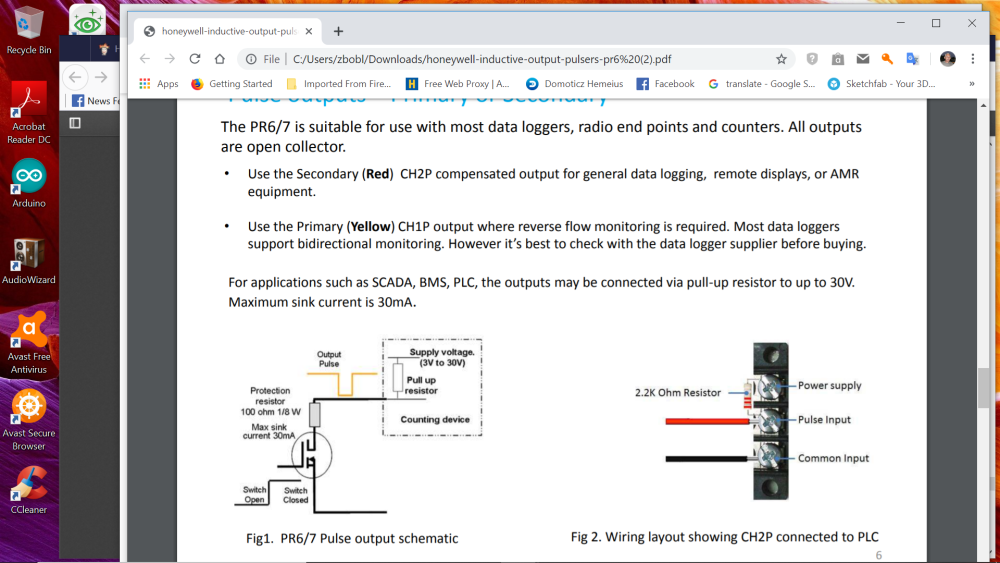How to get 5v pulse from a water meter
-
Hi
i have a water meter with a pulse out. this i ned to connect to a arduino now and maybe some other device later, so i need the pulse to 5v. now i can't get any good volt reading from the pulse. the only good reading i get is a value 10-40 Kohm pr. pulse. is there a way to fix this?
I'm thinking like a solid stat relay or a pulse or ohm to volt converter.
the solution need to handle up to minimum 35 pulses a second
it stands in the manual that i can use a pull up resistor. i have tried this with 5v and a range from 2-6 Kohms resistors but the i get a constant 5 voltsomeone that can help?
i add the sensor manual
its the PR7 version. -
Hi
i have a water meter with a pulse out. this i ned to connect to a arduino now and maybe some other device later, so i need the pulse to 5v. now i can't get any good volt reading from the pulse. the only good reading i get is a value 10-40 Kohm pr. pulse. is there a way to fix this?
I'm thinking like a solid stat relay or a pulse or ohm to volt converter.
the solution need to handle up to minimum 35 pulses a second
it stands in the manual that i can use a pull up resistor. i have tried this with 5v and a range from 2-6 Kohms resistors but the i get a constant 5 voltsomeone that can help?
i add the sensor manual
its the PR7 version.@pelle84 said in How to get 5v pulse from a water meter:
someone that can help?
i add the sensor manual
its the PR7 version.I think you need to be a little bit more specific about what PR7 type you bought. I see a multiple of schematics in the manual, and only you know which one to use as you know what device you've bought.
Suggestion: publish the schematic from the manual that corresponds with your device.Another question: How dit you connect the device to the arduino, and how is it powered (internal battery or via the arduino or via an external power supply). Again, as you're not specific about the device you have, we can't be of help I'm afraid.
Suggestion: draw the schematic or make an image, and publish that.
BR, Boozz
-
Hi
i have a water meter with a pulse out. this i ned to connect to a arduino now and maybe some other device later, so i need the pulse to 5v. now i can't get any good volt reading from the pulse. the only good reading i get is a value 10-40 Kohm pr. pulse. is there a way to fix this?
I'm thinking like a solid stat relay or a pulse or ohm to volt converter.
the solution need to handle up to minimum 35 pulses a second
it stands in the manual that i can use a pull up resistor. i have tried this with 5v and a range from 2-6 Kohms resistors but the i get a constant 5 voltsomeone that can help?
i add the sensor manual
its the PR7 version.@pelle84 I suspect you misunderstand how the sensor works, but a bit shocked you expect 35 litres/second as the smallest K Elster make 1, or 1 litre per pulse.
I have a PR6 pulse (K=1) on my domestic meter, in this case to a 3.3v PM. From vague memory, power and earth are applied to the sensor with a drop resistor (2k2?) from power to the PM's interrupt. When the internal mosfet of the sensor pulls the pin low it triggers the IRQ, the PM increments and radios in the new value.
Not in a position to open up the case to get details for now but if your PR7 is similar, that is how a pulse module works. Why I did it that way rather than an input pullup of the IRQ I cannot recall, but it still has the same 2xAA from 2 years ago.. -
Just home so opened the Node case and glad to confirm despite ageing my recollection was accurate.
This screenshot is common to the PR6/7 using CH2P if it is a undirectional flow.

Looking at the circuit afresh I see no reason why the internal input pullup of IRQ should not work either through a drop resistor or possibly direct, since all it does is sink the signal, which the IRQ will pick up as Change/Falling/Low. From vague memory of the sketch, mine is triggered on LOW.
1 - Unlike Reed switches (my gas reed duration is ca 6 seconds) mosfets are fast, so the pulse duration is so short it will not register on your multimeter hence the perceived uninterrupted 5v. The PR7 spec you posted says 10ms duration...
2 - If envisaging a standalone radio node such as deployed here, you may be better going with a 3.3v PM to begin with rather than mess about with level converters later...
Hope this helps...
